Hip pain is a common struggle during pregnancy, and it can make getting good sleep much harder.
As your body changes to support your growing baby, your hips carry extra pressure and strain. This discomfort often shows up at night when you’re trying to rest, leaving you tired and frustrated.
The good news is that there are safe, simple ways to find relief. The right sleeping positions, supportive pillows, and small changes to your daily routine can make a big difference.
In this blog, you’ll learn why hip pain happens, the best positions to try, and tips that help you rest better.
Why Hip Pain Happens During Pregnancy
Hip pain during pregnancy is very common. The body goes through many changes to make space for the baby, and these changes can affect the joints and muscles.
One reason is hormones. A hormone called relaxin loosens your joints and ligaments to prepare for birth. While this is important, it can also make your hips feel unstable or sore.
As your uterus grows, it puts extra pressure on your hips and pelvis. This added weight can make lying down uncomfortable, especially at night.
Your sleeping posture also plays a role. Lying in the wrong position may limit blood flow and add stress to your hips, leading to more pain when you wake up
Best Sleeping Positions for Hip Pain While Pregnant
Finding the right sleep position can make a big difference when hip pain keeps you awake at night. The goal is to stay comfortable while also supporting your baby’s health.
1. Left Side Sleeping (SOS Method)
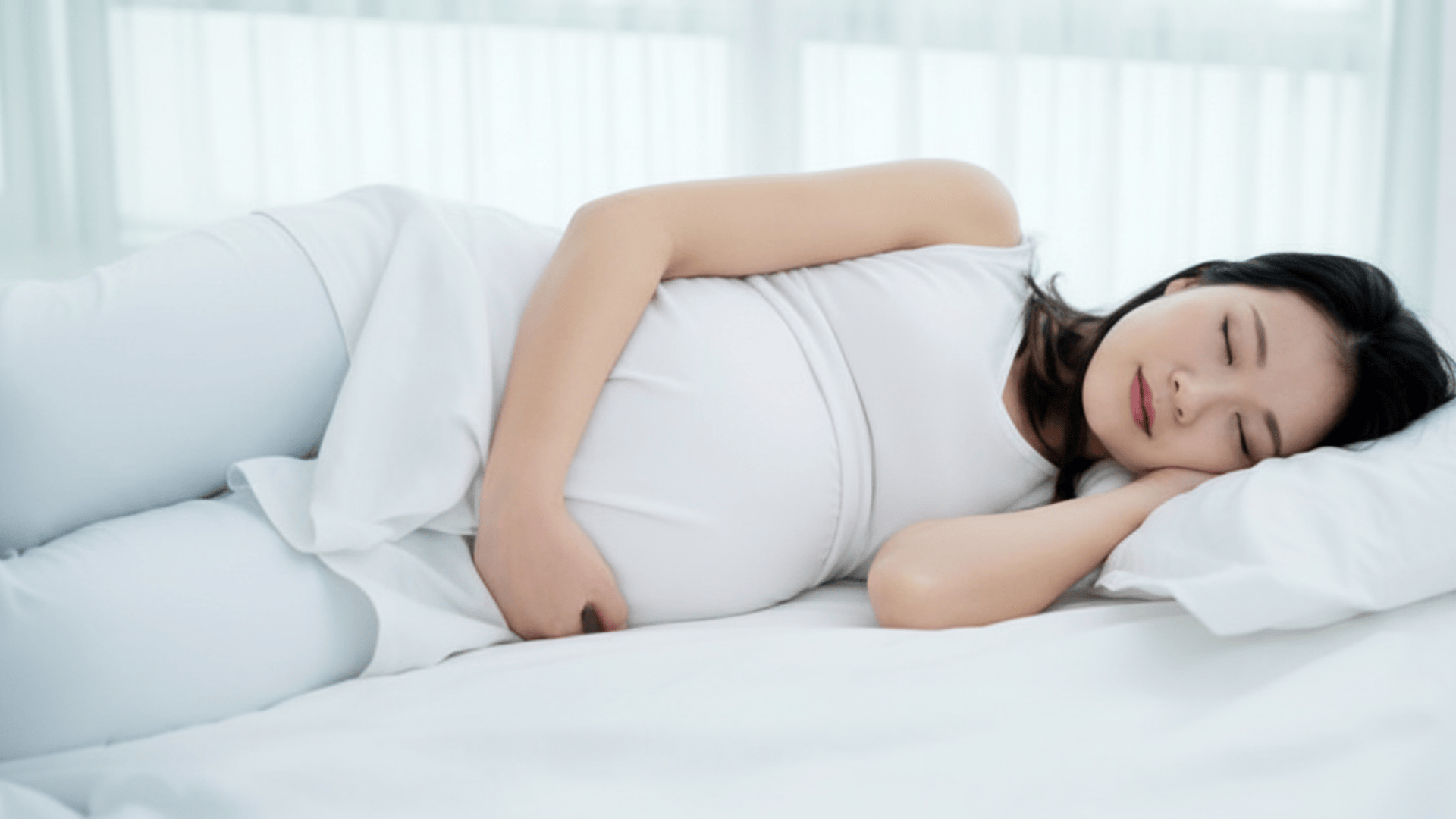
Sleeping on your left side is the most recommended position during pregnancy. It helps improve blood flow and gives your baby more oxygen and nutrients.
To reduce hip pain, keep your knees slightly bent and place a pillow between them. This keeps your hips, pelvis, and spine in better alignment.
2. Right Side Sleeping
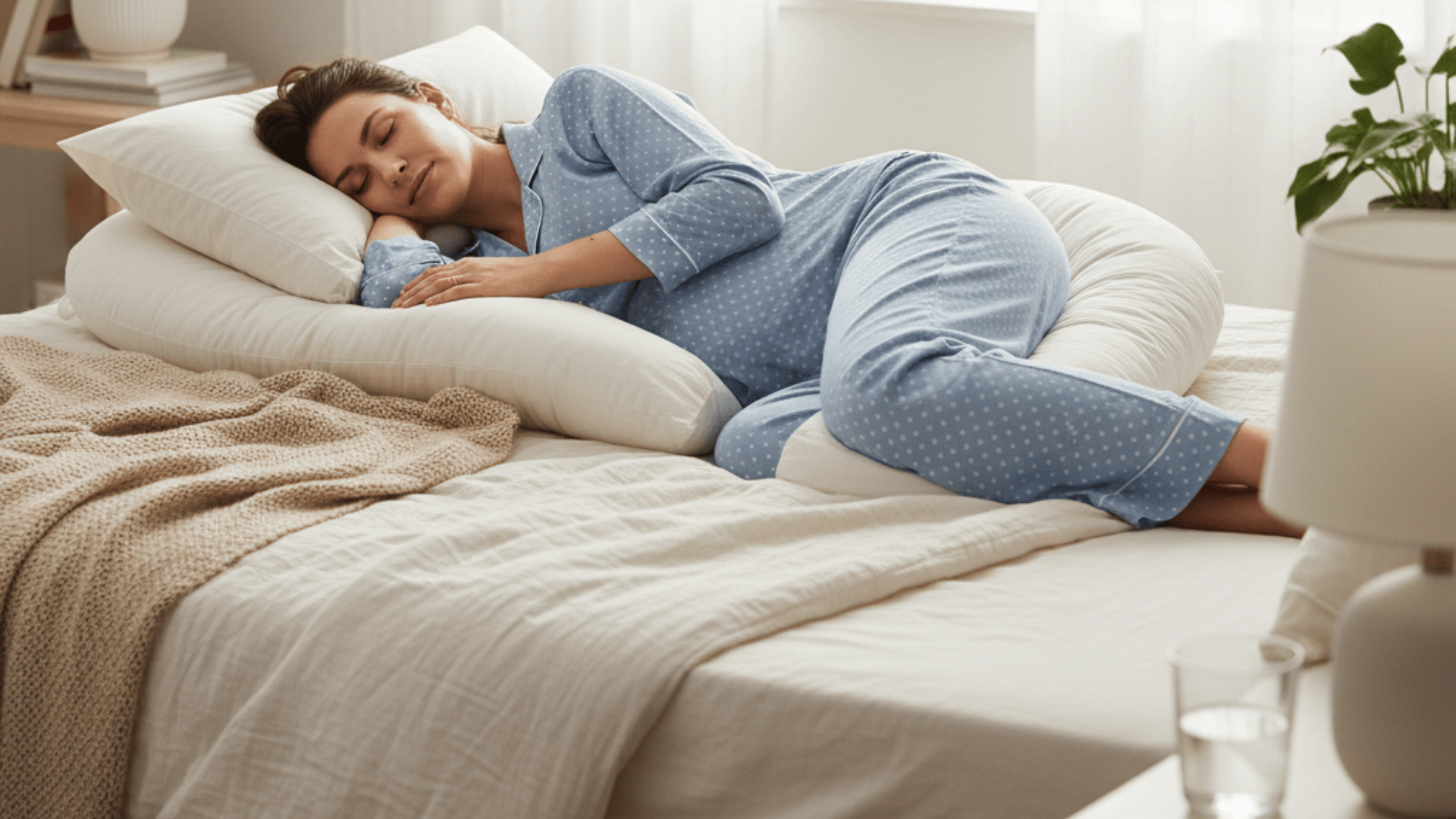
If staying on your left side all night feels impossible, sleeping on your right side is still safe. It may not improve circulation as much as the left, but it does help ease pressure on your hips.
Add a pillow between your knees or under your bump to reduce strain. Switching between the left and right sides during the night can also prevent stiffness.
3. Fetal Position

Curling into a gentle fetal position can relax your hip muscles. Tucking your knees toward your chest shortens tight hip tissues and makes it easier to rest.
This position works especially well in late pregnancy when your belly feels heavy. To stay supported, hug a pillow or use a full-length pregnancy pillow for extra comfort.
4. Modified Back Sleeping
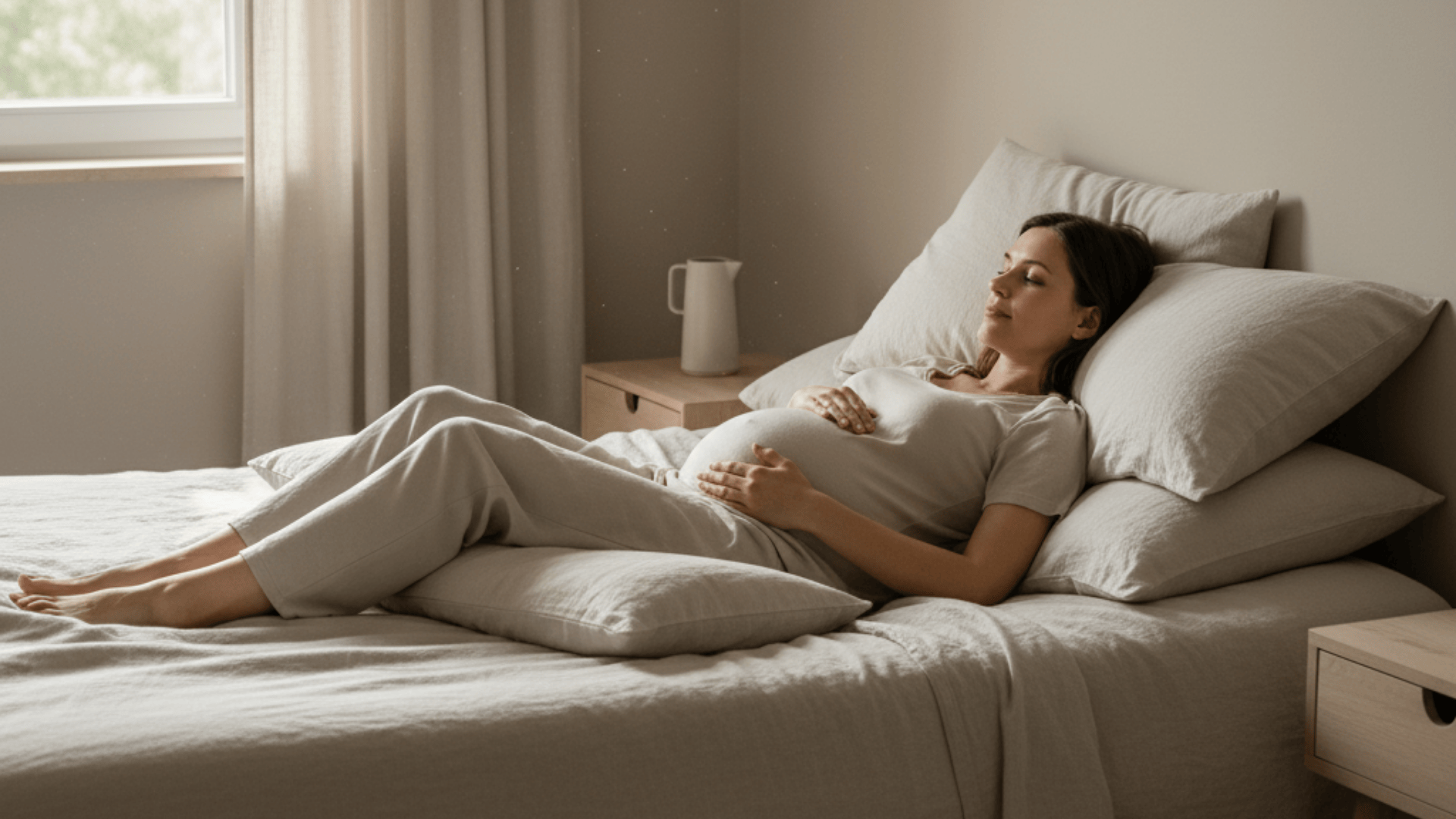
If side sleeping starts to feel uncomfortable, you can try a modified back position. Lean back slightly and place pillows under your knees and hips for support.
This helps reduce pressure on your joints without lying flat on your back. It’s best used for short periods, especially in the later months, since lying flat may affect blood flow.
5. Side Sleeping with Pillow Between Knees
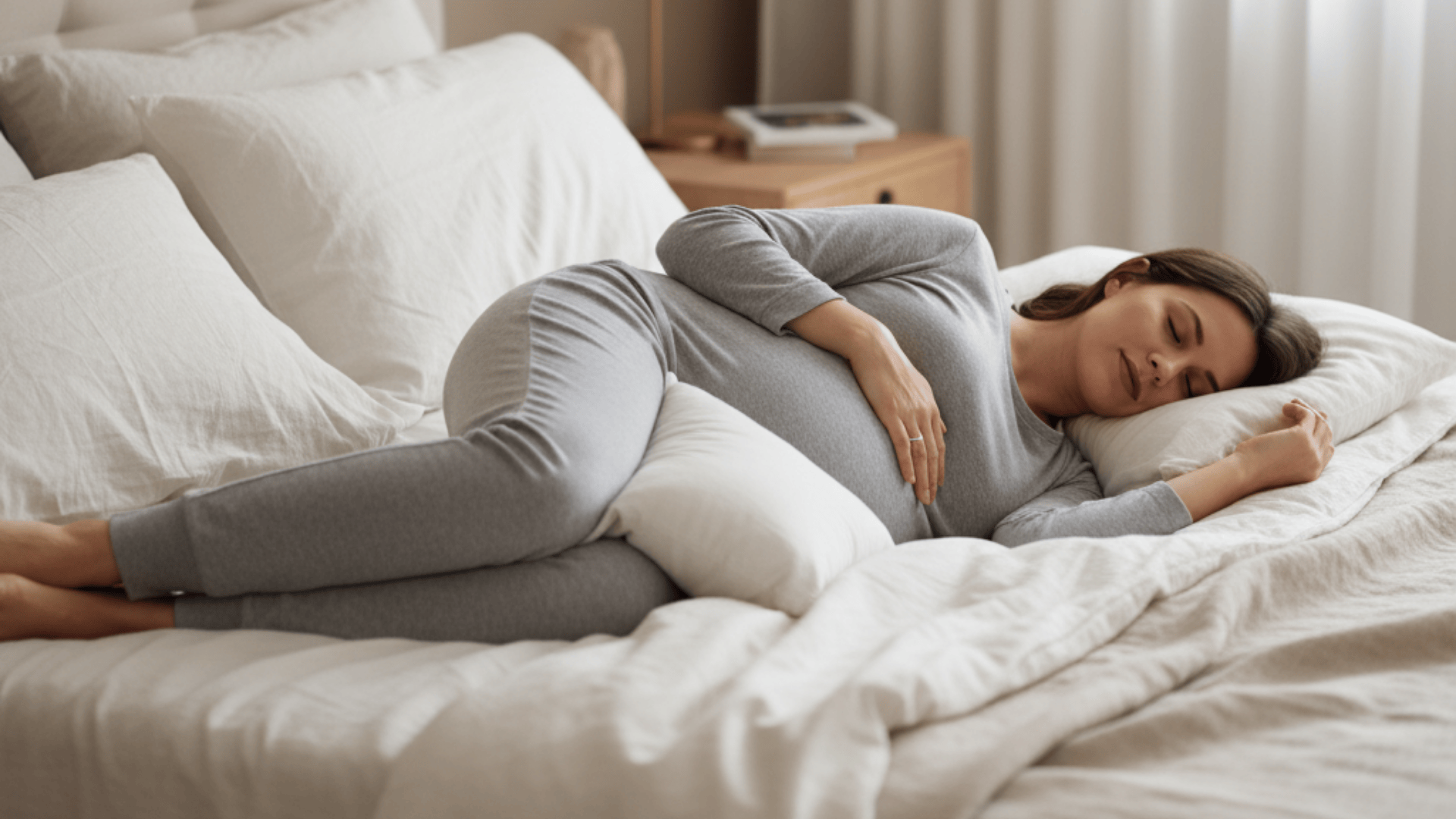
Adding a pillow between your knees can make side sleeping much more comfortable. It keeps your hips, pelvis, and spine in line, which helps reduce pressure on your joints.
A small, firm pillow works well, or you can use a body pillow for full support. This position not only eases hip pain but also prevents your top leg from pulling your hips out of alignment while you sleep.
6. Elevated Hip Position with Wedge Pillow
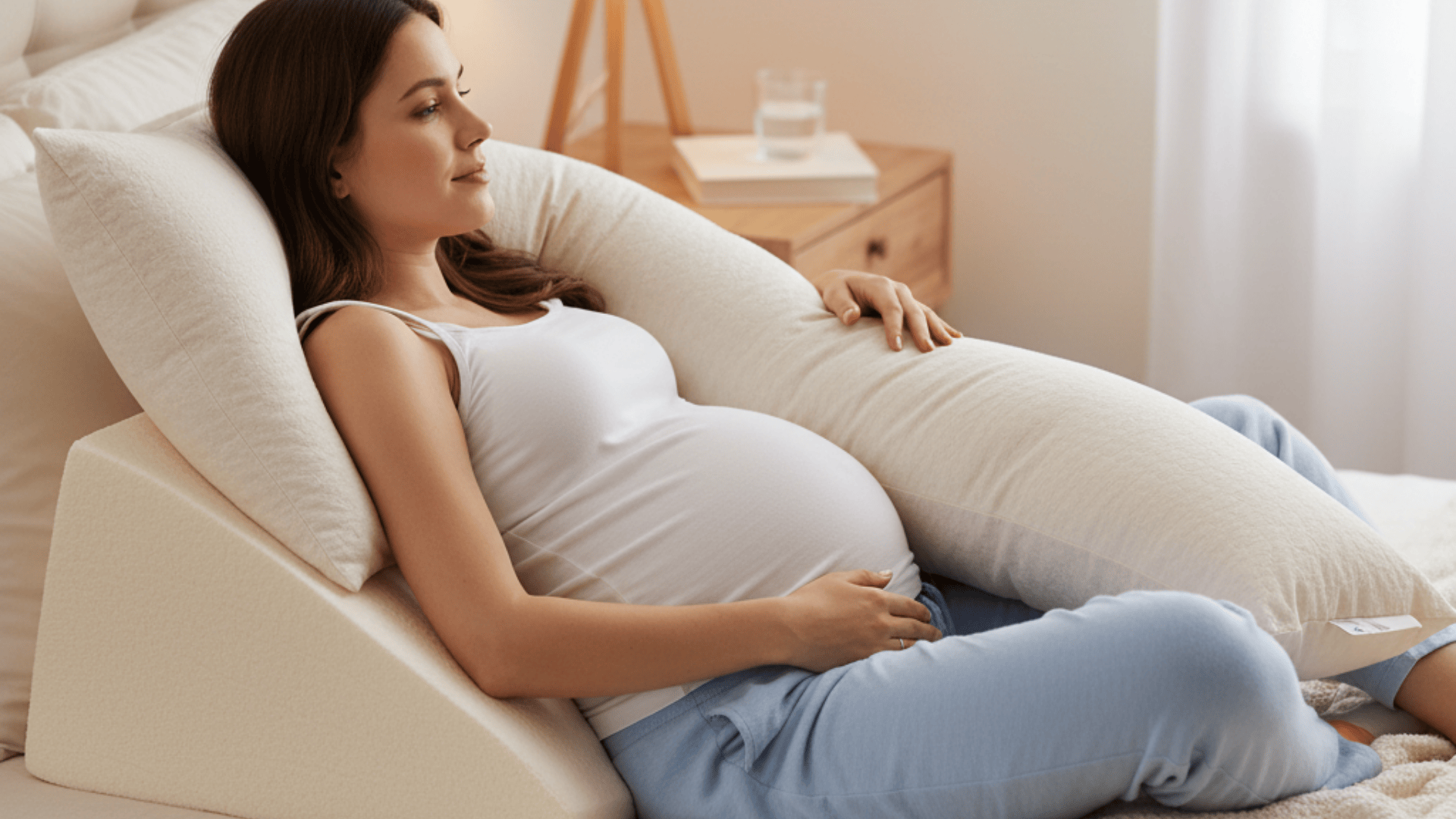
A wedge pillow placed under one hip can take pressure off your pelvis. This slight lift helps relieve tension in the hips and lower back. It’s also useful if you tend to roll from side to side during the night.
You can pair a wedge pillow with a body pillow for even more stability. This position is especially helpful for moms who find side sleeping alone isn’t enough to reduce their hip pain.
Best Pillow and Placement for Pregnancy Hip Pain
The right pillow can make a big difference, but combining it with smart placement brings even more relief. Some pillow setups work better at different stages of pregnancy, offering stability, comfort, and improved sleep quality:
| Combo | Why It Works Best | Best Trimester | Extra Benefit |
|---|---|---|---|
| Body Pillow + Between Knees | Full-body support keeps hips aligned, reduces twisting, and eases night-time stiffness | 2nd & 3rd | Improves circulation and makes it easier to switch sides during the night |
| Wedge Pillow + Under Belly | Lifts belly weight, relieves forward pull, and reduces hip strain | All | Compact design works well in bed or on a couch for naps |
| U-Shaped Pillow + Behind Back | Prevents rolling, keeps the body centered, and supports both front and back | 3rd | Offers stable support for the heavy belly and reduces lower back discomfort |
| Knee Pillow + Between Knees | Simple fix for hip alignment, reduces joint pressure, and prevents leg pulling | 2nd | Small and travel-friendly, easy to use when sharing bed space |
| C-Shaped Pillow + Under Belly | Wraps around the body while easing strain from belly weight and hip tension | 2nd & 3rd | Provides a hugging effect that also helps reduce anxiety and improve relaxation |
Trying these pillow and placement combinations can ease hip pressure, keep your body aligned, and give you more restful nights. Experiment with different setups until you find the one that feels most comfortable for your body and stage of pregnancy.
Sleeping Positions to Avoid
Some sleep positions may feel natural, but can actually add to hip pain or affect circulation during pregnancy.
Stomach sleeping becomes unsafe as your belly grows. It puts pressure on your hips, lower back, and bump, making it uncomfortable and risky for both you and your baby.
Flat back sleeping is also not advised in the second and third trimesters. Lying fully on your back can press on a major vein, slowing blood flow and causing dizziness or added hip strain.
These positions can also make it harder to maintain proper hip alignment. Over time, they may worsen discomfort and affect the quality of your rest.
Daytime Habits That Support Better Sleep
What you do during the day can affect how your hips feel at night. Simple posture and movement habits ease pressure on your joints and make it easier to rest once you go to bed:
- Mind your sitting posture: Use a chair with back support and keep both feet flat on the floor. Crossing your legs for long periods can strain your hips.
- Take breaks from sitting or standing: Switching positions every 30–60 minutes helps keep your hips from tightening up. Gentle walks or stretches during the day make it easier to rest at night.
- Wear supportive shoes: Cushioned footwear with good arch support reduces stress on your hips and pelvis during daily activities. Avoid high heels or unsupportive flats.
- Use a footrest if needed: Elevating your feet slightly while sitting takes pressure off the lower back and hips.
- Practice gentle pelvic tilts: Small movements while standing or sitting can keep your hips flexible and prevent stiffness from building up.
By combining healthy daytime habits with the right sleep positions and pillow support, you give your hips the best chance to stay comfortable through the night..
Tips and Hacks for Reducing Hip Pain at Night
Relieving hip pain at night isn’t only about sleeping position. Small changes in your routine and practical tricks from other moms can make rest more comfortable:
- Gentle hip stretches before bed: Simple moves like seated butterfly stretches or light leg lifts relax tight muscles and reduce stiffness.
- Heat or cold therapy: A warm compress loosens sore muscles, while a cold pack calms inflammation. Using one or both can bring relief before sleep.
- Supportive mattress or topper: A firm bed or memory foam topper spreads weight evenly and reduces hip strain.
- Light exercise during the day: Short walks or prenatal yoga improve circulation, flexibility, and overall comfort at night.
- Pillow adjustments: Leaning forward onto a thick pillow, or stacking smaller ones under your hips, knees, or back, gives custom support as your body changes.
- Sleeping in a recliner: A reclined chair can ease pressure on the hips when bed positions feel uncomfortable.
These strategies work best when paired with the right pillows and safe sleeping positions, helping you rest with less pain and more comfort.
When to See a Doctor
Hip pain during pregnancy is common, but sometimes it can point to something more serious. It’s important to pay attention to your symptoms and know when to get medical help.
Seek advice from your doctor if the pain is severe or doesn’t go away with rest and simple remedies. Constant discomfort could be a sign that something else is going on.
You should also reach out if the pain makes it hard to walk, stand, or do daily tasks. Limiting mobility can affect both your comfort and safety.
Another red flag is pain that comes with swelling, cramping, or other unusual symptoms. These may signal complications that need professional care.
Conclusion
Hip pain during pregnancy can make restful sleep feel impossible, but the right habits and support can ease the strain.
Choosing safe sleep positions, using pillows wisely, and adjusting daily routines all help reduce discomfort and protect your hips.
Every pregnancy is unique, so it’s important to listen to your body and try different solutions until you find what feels best.
If pain becomes severe or limits your daily life, don’t hesitate to talk to your doctor for extra support.
Start with one or two of these tips tonight, and give yourself the chance to rest better – you and your baby both deserve it.










